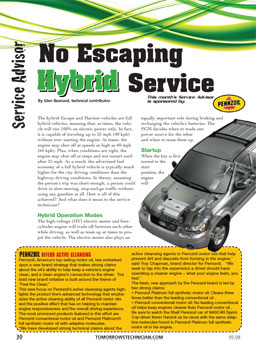 By Glen Beanard
By Glen Beanard
The hybrid Escape and Mariner vehicles are full hybrid vehicles, meaning that, at times, the vehicle will run 100% on electric power only. In fact, it is capable of traveling up to 25 mph (40 kph) without ever starting the engine.
At times, the engine may shut off at speeds as high as 40 mph (64 kph). Plus, when conditions are right, the engine may shut off at stops and not restart until after 25 mph. As a result, the advertised fuel economy of a full hybrid vehicle is typically much higher for the city driving conditions than the highway driving conditions.
In theory, assuming the person’s trip was short enough, a person could drive in slow-moving, stop-and-go traffic without using any gasoline at all. How is all of this achieved? And what does it mean to the service technician?
Hybrid Operation Modes
The high-voltage (HV) electric motor and four-cylinder engine will trade off between each other while driving, as well as team up at times to propel the vehicle. The electric motor also plays an equally important role during braking and recharging the vehicle’s batteries. The PCM decides when to trade one power source for the other and when to team them up.
Startup
When the key is first turned to the start position, the engine will start. Since there’s no conventional electric starter on the vehicle, this action is performed by the 330-volt electric motor located inside the transmission. There’s no starter noise that is normally associated with an engine under crank conditions.
The only noise is the engine suddenly running. If the high-voltage battery has a proper charge, and the climate control demands will allow it, the engine will shut back off after a minute or two.
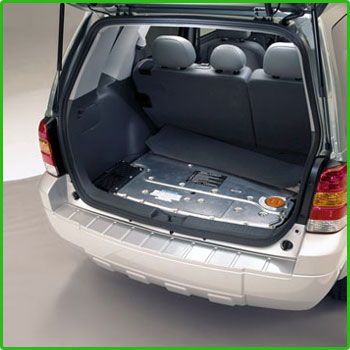 Electric Drive
Electric Drive
The first movements from the vehicle, under light throttle, are silent as only the electric motor propels the vehicle along at slow speeds. It will remain in electric drive mode up to 25 mph under light throttle, as long as the HV batteries do not run low on charge or too hot, or the climate control needs do not require the engine to start.
Regenerative Braking
During the deceleration process, the traction motor becomes a voltage generator. This effectively slows the vehicle down in conjunction with the friction brake system. The traction motor is capable of generating up to 397 volts and 78 amps.
The high voltage generated from the traction motor is sent to two different locations. One location is the high-voltage batteries under the floor of the cargo area (see Photo 1), and the other is the DC to DC converter located on the right inner fender (see Photo 2).
The DC/DC converter replaces the need for a belt-driven alternator. The DC/DC converter steps the high voltage 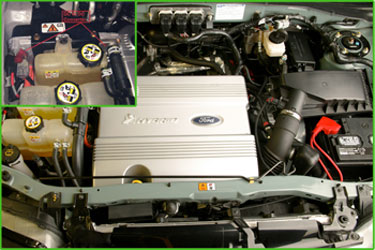 down to 12 volts. During this voltage step-down process, the output amperage is multiplied. The DC/DC converter is equal to a 110-amp alternator.
down to 12 volts. During this voltage step-down process, the output amperage is multiplied. The DC/DC converter is equal to a 110-amp alternator.
This serves to power the 12-volt electrical system and recharge the conventional lead/acid 12-volt battery under the hood. The ABS module calculates the amount of braking desired by the driver based on input from the accelerator pedal position sensor, the brake pedal pressure sensor on the master cylinder and the longitudinal accelerometer.
This information is shared with the PCM so that the PCM can control the transmission to generate voltage from the traction motor. Simply letting off of the gas pedal signals for some regenerative braking, applying the brake pedal signals for more.
Electrical-Assisted Driving
Normally at highway speeds, the gasoline engine is powering the vehicle. However, when more torque is needed (such as when passing), the electric motor will kick in and add its torque to the driveline as well. As a result, the little 2.3L may now feel more like a 3.0L to the driver.
At times, the electric motor may pull the high-voltage batteries down to as low as 216 volts, and it may draw as much as 181 amps.
The engine used in the hybrid Escape and Mariner is a 133 hp to 155 hp (model year dependent) Atkinson cycle 2.3L engine. An Atkinson cycle engine uses cam lobe profile to hold the intake valve open during a small part of the compression stroke.
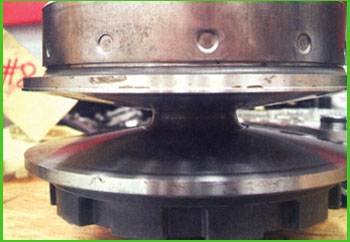 Doing this lowers the amount of energy used to compress the air/fuel mixture, allowing a 7-10% increase in fuel economy over a standard Otto cycle design. The transmission in the hybrid Escape/Mariner is an electronically controlled continuously variable transmission (eCVT). There is no actual shifting occurring in the eCVT because the gear ratios are achieved by a belt-like chain running inside of V-shaped “pulleys” that vary their width as needed to walk the chain higher or lower in them. (See Photo 3)
Doing this lowers the amount of energy used to compress the air/fuel mixture, allowing a 7-10% increase in fuel economy over a standard Otto cycle design. The transmission in the hybrid Escape/Mariner is an electronically controlled continuously variable transmission (eCVT). There is no actual shifting occurring in the eCVT because the gear ratios are achieved by a belt-like chain running inside of V-shaped “pulleys” that vary their width as needed to walk the chain higher or lower in them. (See Photo 3)
Since the engine is not always running on a full hybrid vehicle, some changes are made in regards to the brake system and power steering system as well as some operating differences in the climate control system.
Friction Brake System
Since engine vacuum cannot be relied upon to be present, the power brake system does not have a vacuum brake booster. This vehicle uses an electro-hydraulic brake (EHB) system. The EHB master cylinder is also referred to as an actuation control unit (ACU). The bore of the ACU is called a pedal feel emulator and is primarily used to simulate normal brake pedal feel for the driver.
The pressure generated for the calipers is not, under normal conditions, the direct result of the driver’s foot pedal efforts. Normally, this fluid pressure is generated by the ABS HCU and is regulated by the teamed efforts of the ABS and PCM’s logic. Under normal conditions, the driver’s pedal efforts are displaying to the ABS module as a “request” for braking.
The ABS and PCM then divide the braking effects between the traction motor (for regenerative braking) and the friction brakes as needed. Only in the event that the ABS pump can’t function to build pressure does the driver’s pedal pressure directly provide the hydraulic pressure for the calipers.
There are valves inside the HCU that allow direct passage from the pedal feel emulator chamber of the ACU, through the HCU and to the wheels. This is called “manual mode.” In manual mode, there will be no boost so the driver will have a very hard/stiff brake pedal.
The replacement of the friction material is the same as with a conventional system, however, the ABS module does test the brake hydraulic system’s integrity by pressurizing it during key-off events, such as opening the door or whenever the dome light is activated, and again when the key is switched on.
After four minutes have passed since the key was switched off, the accumulator discharges its stored fluid pressure back into the master cylinder reservoir. Before attempting friction material replacement, you must disconnect the battery to prevent the likelihood of an accumulator discharge event, or a system pressurization, during service. In addition to battery disconnect, Ford says to remove fuses 24 (50A) and 31 (50A) in the battery junction box.
If system bleeding is required, a scan tool must be used for the ABS service bleed. Plus, a pressure bleeder set to deliver a continuous 35 psi is needed during the bleeding process. Ford says do not use a vacuum bleeder on this system.
Steering
Like the brake system, the steering system is impacted by the fact that the engine is not always running. So, the hybrid Escape/Mariner uses an electric power assisted steering system (EPAS). The EPAS uses an electric power steering motor to assist the driver’s efforts.
The power steering motor is controlled by the power steering control module (PSCM). The PSCM watches a steering position sensor on the column shaft to determine the driver’s input at the steering wheel. It combines input from the PCM, such as vehicle speed, to control the amount of assist it applies through the assist motor.
Climate Control
Since the A/C compressor is one of only two things that the engine-driven belt powers, the engine may be commanded on for A/C request, depending on the A/C control switch setting. When looking at the A/C controls on these vehicles, you will see three settings: A/C, A/C with recirculation and MAX A/C.
On a conventional vehicle, A/C with recirculation and MAX A/C were the same thing, but not on a hybrid Escape/Mariner. There’s one difference: the MAX A/C setting will override the hybrid engine shutdown feature, whereas the normal A/C and A/C with recirculation will not. The defroster, and defrost with floor (high and low setting) will also override the hybrid engine shutdown feature.
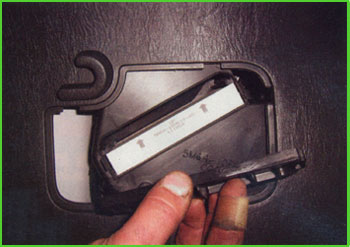 The A/C system on the hybrid also serves another purpose: to cool the HV battery. The A/C system on the hybrid contains a dedicated second evaporator core for the HV battery. There are also front and rear shut-off valves in the liquid lines for the front and rear evaporator cores that are controlled by the PCM, so that the two halves of the A/C system can be controlled independently.
The A/C system on the hybrid also serves another purpose: to cool the HV battery. The A/C system on the hybrid contains a dedicated second evaporator core for the HV battery. There are also front and rear shut-off valves in the liquid lines for the front and rear evaporator cores that are controlled by the PCM, so that the two halves of the A/C system can be controlled independently.
If the driver requests A/C, but the HV battery does not require cooling, the front valve is opened and the rear one is closed. If the HV battery requires cooling at the same time the driver wants cooling, then the rear valve is opened. If the HV battery requires cooling, and the driver doesn’t request it, the traction battery control module (TBCM) makes a request for A/C to the PCM. The PCM 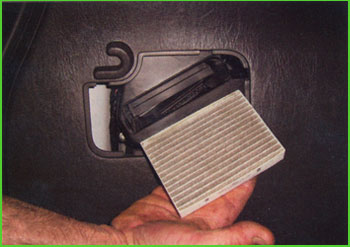 will then start the engine (if needed), activate the compressor and open only the rear valve to provide air-conditioned cooling to the HV battery.
will then start the engine (if needed), activate the compressor and open only the rear valve to provide air-conditioned cooling to the HV battery.
The air intake for the HV battery cooling is located at the rear edge of the driver’s side cargo area side glass.
The air flow for the HV battery is filtered by a serviceable filter located behind the left cargo trim panel. See Photos 4 and 5. The normal service recommendation for this filter is to be inspected and replaced as needed every 10,000 miles (16,000 km). The air flow from the HV battery exists under the vehicle, behind the bumper on the driver’s side.
Since heat for the heater function requires a warm engine, the engine may start up as needed to heat the coolant. However, in spite of the belt-driven water pump, the engine does not need to stay running once the coolant is heated. There is a 12-volt power pump located in the heater hose that is commanded on by the PCM to produce coolant flow between the heater core and the hot engine block. Naturally, the engine may be commanded off and on repeatedly while on heater setting to warm the coolant as needed.
A Tale of Two Cooling Systems
Did you catch the two coolant reservoirs in the DC/DC converter picture? Yes, you were seeing double, but that’s OK. The forward-positioned bottle is for the engine cooling system and heater core. The rearward-mounted one is to cool the DC/DC converter, TCM and electric motor. It’s a separate cooling system all to its own containing its own radiator (located between the condenser and engine’s radiator) and its own hoses. It is filled with Motorcraft Gold coolant and has an air bleed screw that is located on top of the eCVT.
High-Voltage Battery
The HV battery is located under the carpet in the cargo area. It’s comprised of 250 nickel metal hydride cells that produce a total of 330 volts. Inside the housing of the HV battery is the TBCM, a jump-start battery charger, air flow ducts, cooling fins and an HV disconnect relay.
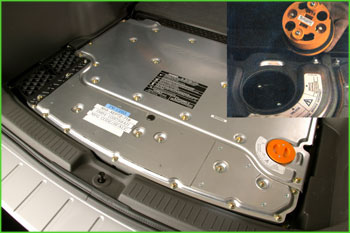 For cold weather states and Canada, the HV battery also contains a heater that will activate automatically if the battery temperature drops below 50° F (10° C). None of the internal parts are serviceable separately. The only serviceable part is a semi-internal disconnect switch/fuse. See Photo 6. If the fuse inside the disconnect switch is blown, the disconnect switch must be replaced.
For cold weather states and Canada, the HV battery also contains a heater that will activate automatically if the battery temperature drops below 50° F (10° C). None of the internal parts are serviceable separately. The only serviceable part is a semi-internal disconnect switch/fuse. See Photo 6. If the fuse inside the disconnect switch is blown, the disconnect switch must be replaced.
Bits and Pieces
• It’s the high-voltage battery that starts the engine, not the low voltage. Therefore, if the HV battery has run low, a special method is used to jumpstart the vehicle. Press the jumpstart button located behind the driver’s kick panel. That will start an eight-minute timer that charges the HV battery from the low-voltage battery.
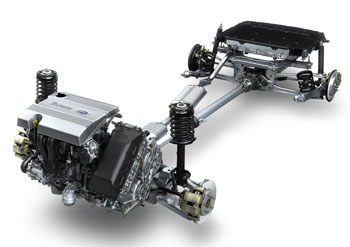 If the low-voltage battery is dead as well, then a “donor” source of 12-volt power (such as another car, 12-volt charger or jumper pack) will need to be added in the traditional manner. Attempt to start the engine after the eight-minute charge is complete.
If the low-voltage battery is dead as well, then a “donor” source of 12-volt power (such as another car, 12-volt charger or jumper pack) will need to be added in the traditional manner. Attempt to start the engine after the eight-minute charge is complete.
• The engine uses a cartridge-style oil filter and 5w20 oil. The oil change service interval is every 10,000 miles for normal service.
• These vehicles have two inertia switches; one in the front and one in the back. The front switch cuts off fuel and high voltage directly. The rear only cuts high voltage directly, and fuel indirectly via the PCM. The rear switch disconnects faster than the front.
• Due to the regenerative braking coming from the front wheels, the front hydraulic brakes are not applied as strongly as the rear are most of the time. Therefore, it is normal for the rear fiction linings to wear faster than the front.
• The eCVT transmission is a “fill for life” design.
Note, to print a copy of the Ford Escape Hybrid Emergency Response guide, click here.


